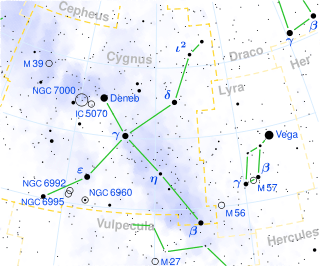Zeta Cygni
Zeta Cygni (ζ Cyg) is a binary star system in the northern constellation of Cygnus, the swan. It has an apparent visual magnitude of 3.26 and, based upon parallax measurements, is about 143 light-years (44 parsecs) away.
| Observation data Epoch J2000.0 Equinox J2000.0 | |
|---|---|
| Constellation | Cygnus |
| Right ascension | 21h 12m 56.18594s[1] |
| Declination | +30° 13′ 36.8957″[1] |
| Apparent magnitude (V) | 3.26[2] |
| Characteristics | |
| Spectral type | G8IIIa + DA4.2[3] |
| U−B color index | +0.77[2] |
| B−V color index | +0.98[2] |
| Astrometry | |
| Radial velocity (Rv) | +15.85 ± 0.26[4] km/s |
| Proper motion (μ) | RA: +6.51[1] mas/yr Dec.: –68.21[1] mas/yr |
| Parallax (π) | 22.79 ± 0.35[1] mas |
| Distance | 143 ± 2 ly (43.9 ± 0.7 pc) |
| Absolute magnitude (MV) | –0.01[5] |
| Orbit[6] | |
| Period (P) | 6,489 ± 31 days |
| Semi-major axis (a) | 0.19"[7] |
| Eccentricity (e) | 0.22 ± 0.03 |
| Periastron epoch (T) | 40,712 ± 178 MJD |
| Argument of periastron (ω) (secondary) | 41 ± 10° |
| Semi-amplitude (K1) (primary) | 3.31 ± 0.12 km/s |
| Details | |
| ζ Cyg A | |
| Mass | 3.05[8] M☉ |
| Radius | 15[4] R☉ |
| Luminosity | 112[4] L☉ |
| Surface gravity (log g) | 2.41[5] cgs |
| Temperature | 4,910[5] K |
| Metallicity [Fe/H] | –0.04[5] dex |
| Rotational velocity (v sin i) | 0.4 ± 0.5[8] km/s |
| Age | 0.2[9] Gyr |
| ζ Cyg B | |
| Mass | 0.6[7] M☉ |
| Temperature | 12,000[7] K |
| Other designations | |
| Database references | |
| SIMBAD | data |
The primary component, ζ Cyg A is a giant star with a spectral type of G8 IIIp. Its most likely status is as a red clump giant, an evolved star that has begun core helium fusion. It has around three times the mass of the Sun and has expanded to about 15 times the Sun's radius. It is radiating 112 times the brightness of the Sun from its outer atmosphere at an effective temperature of 4,910 K. At this temperature, the star glows with the yellow hue of a G-type star.[11]
The secondary component, ζ Cyg B, is a white dwarf of type DA4.2. The pair orbit each other every 6,489 days (17.8 years) with an eccentricity of 0.22. The white dwarf cannot be seen directly, but is estimated to have an apparent magnitude of 13.2.[3]
Zeta Cygni has an overabundance of barium, as well as other heavy chemical elements in its atmosphere, making it a so-called "mild" barium star. These elements were synthesized by the other member of the system as it passed through the asymptotic giant branch (AGB) stage of its evolution, then ejected in its stellar wind and accreted onto the current primary component. Prior to acquiring this additional mass, Zeta Cygni had about 2.5 times the mass of the Sun, while the more evolved AGB star had three solar masses.[8]
References
- van Leeuwen, F. (November 2007), "Validation of the new Hipparcos reduction", Astronomy and Astrophysics, 474 (2): 653–664, arXiv:0708.1752, Bibcode:2007A&A...474..653V, doi:10.1051/0004-6361:20078357
- Fernie, J. D. (May 1983), "New UBVRI photometry for 900 supergiants", Astrophysical Journal Supplement Series, 52: 7–22, Bibcode:1983ApJS...52....7F, doi:10.1086/190856
- Holberg, J. B.; Oswalt, T. D.; Sion, E. M.; Barstow, M. A.; Burleigh, M. R. (2013). "Where are all the Sirius-like binary systems?". Monthly Notices of the Royal Astronomical Society. 435 (3): 2077. arXiv:1307.8047. Bibcode:2013MNRAS.435.2077H. doi:10.1093/mnras/stt1433.
- Massarotti, Alessandro; et al. (January 2008), "Rotational and Radial Velocities for a Sample of 761 HIPPARCOS Giants and the Role of Binarity", The Astronomical Journal, 135 (1): 209–231, Bibcode:2008AJ....135..209M, doi:10.1088/0004-6256/135/1/209
- Allen, D. M.; Porto de Mello, G. F. (January 2011), "Mn, Cu, and Zn abundances in barium stars and their correlations with neutron capture elements", Astronomy and Astrophysics, 525: A63, arXiv:1009.4688, Bibcode:2011A&A...525A..63A, doi:10.1051/0004-6361/200912356
- Griffin, R. F.; Keenan, P. C. (August 1992), "Spectroscopic binary orbits from photoelectric radial velocities. Paper 105: zeta Cygni", The Observatory, 112: 168–182, Bibcode:1992Obs...112..168G
- Barstow, M. A.; et al. (April 2001), "Resolving Sirius-like binaries with the Hubble Space Telescope", Monthly Notices of the Royal Astronomical Society, 322 (4): 891–900, arXiv:astro-ph/0010645, Bibcode:2001MNRAS.322..891B, doi:10.1046/j.1365-8711.2001.04203.x
- Yushchenko, A. V.; Gopka, V. F.; Kim, C.; Liang, Y. C.; Musaev, F. A.; Galazutdinov, G. A. (January 2004), "The chemical composition of the mild barium star HD 202109", Astronomy and Astrophysics, 413 (3): 1105–1114, arXiv:astro-ph/0308337, Bibcode:2004A&A...413.1105Y, doi:10.1051/0004-6361:20031596
- Smiljanic, R.; Porto de Mello, G. F.; da Silva, L. (June 2007), "Abundance analysis of barium and mild barium stars", Astronomy and Astrophysics, 468 (2): 679–693, arXiv:astro-ph/0702421, Bibcode:2007A&A...468..679S, doi:10.1051/0004-6361:20065867
- "zet Cyg". SIMBAD. Centre de données astronomiques de Strasbourg. Retrieved 2012-03-02.
- "The Colour of Stars", Australia Telescope, Outreach and Education, Commonwealth Scientific and Industrial Research Organisation, December 21, 2004, retrieved 2012-01-16
External links
- Zeta Cygni on WikiSky: DSS2, SDSS, GALEX, IRAS, Hydrogen α, X-Ray, Astrophoto, Sky Map, Articles and images
